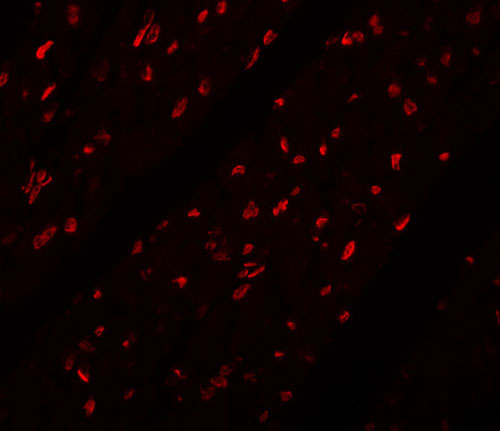MINA Antibody
- 产品详情
- 实验流程
- 背景知识
Application
| WB, IF, E, IHC-P |
|---|---|
| Primary Accession | Q8IUF8 |
| Other Accession | NP_694822, 110227621 |
| Reactivity | Human, Mouse |
| Host | Rabbit |
| Clonality | Polyclonal |
| Isotype | IgG |
| Calculated MW | 52800 Da |
| Concentration (mg/ml) | 1 mg/mL |
| Conjugate | Unconjugated |
| Application Notes | MINA antibody can be used for detection of MINA by Western blot at 1 - 2 µg/mL. Antibody can also be used for immunohistochemistry starting at 5 µg/mL. For immunofluorescence start at 20 µg/mL. |
| Gene ID | 84864 |
|---|---|
| Other Names | Bifunctional lysine-specific demethylase and histidyl-hydroxylase MINA, 1.14.11.-, 60S ribosomal protein L27a histidine hydroxylase, Histone lysine demethylase MINA, MYC-induced nuclear antigen, Mineral dust-induced gene protein, Nucleolar protein 52, Ribosomal oxygenase MINA, ROX, MINA (HGNC:19441) |
| Target/Specificity | MINA; |
| Reconstitution & Storage | MINA antibody can be stored at 4℃ for three months and -20℃, stable for up to one year. As with all antibodies care should be taken to avoid repeated freeze thaw cycles. Antibodies should not be exposed to prolonged high temperatures. |
| Precautions | MINA Antibody is for research use only and not for use in diagnostic or therapeutic procedures. |
| Name | RIOX2 (HGNC:19441) |
|---|---|
| Function | Oxygenase that can act as both a histone lysine demethylase and a ribosomal histidine hydroxylase. Is involved in the demethylation of trimethylated 'Lys-9' on histone H3 (H3K9me3), leading to an increase in ribosomal RNA expression. Also catalyzes the hydroxylation of 60S ribosomal protein L27a on 'His-39'. May play an important role in cell growth and survival. May be involved in ribosome biogenesis, most likely during the assembly process of pre-ribosomal particles. |
| Cellular Location | Nucleus. Nucleus, nucleolus |
| Tissue Location | Expressed in liver, skeletal muscle, heart, pancreas, and placenta. Not detected in brain, lung or kidney Expressed in several lung cancer tissues, but is barely detected in the adjacent non-cancerous tissues. Also highly expressed in several esophageal squamous cell carcinoma (ESCC), and colon cancer tissues, and in various cancer cell lines. |
For Research Use Only. Not For Use In Diagnostic Procedures.
Provided below are standard protocols that you may find useful for product applications.
BACKGROUND
MINA Antibody: MINA is nuclear localized, myc-inducible protein that is thought to play a role in mammalian cell proliferation. Treatment of cancer cells lines such as the colon cancer cell line SW680 with siRNA against MINA inhibits cell growth, demonstrating that MINA may be a potential therapeutic target. MINA regulates several genes related to cell adhesion and metabolism that have also been shown to be regulated by c-Myc, but also regulates other genes whose expression are not modulated by c-Myc such as EGFR, IL-6 and HGF. MINA has also been found to act as a repressor to IL-4 expression in T cells, indicating that it may also play a role in T cell differentiation and genetic variation in T helper type 2 bias.
REFERENCES
Tsuneoka M, Kody Y, Soejima M, et al. A novel myc target gene, mina53, that is involved in cell proliferation. J. Biol. Chem.2002; 277:35450-9.
Teye K, Tsuneoka M, Arima N, et al. Increased expression of a Myc target gene Mina53 in human colon cancer. Am. J. Pathol.2004; 164:205-16.
Komiya K, Sueoka-Aragane N, Sato A, et al. Mina53, a novel c-Myc target gene, is frequently expressed in lung cancers and exerts oncogenic property in NIH/3T3 cells. J. Cancer Res. Clin. Oncol.2010; 136:465-73.
Okamoto M, Van Stry M, Chung L, et al. Mina, an IL4 repressor, controls T helper type 2 bias. Nat. Immunol.2009; 10:872-9.
终于等到您。ABCEPTA(百远生物)抗体产品。
点击下方“我要评价 ”按钮提交您的反馈信息,您的反馈和评价是我们最宝贵的财富之一,
我们将在1-3个工作日内处理您的反馈信息。
如有疑问,联系:0512-88856768 tech-china@abcepta.com.























 癌症的基本特征包括细胞增殖、血管生成、迁移、凋亡逃避机制和细胞永生等。找到癌症发生过程中这些通路的关键标记物和对应的抗体用于检测至关重要。
癌症的基本特征包括细胞增殖、血管生成、迁移、凋亡逃避机制和细胞永生等。找到癌症发生过程中这些通路的关键标记物和对应的抗体用于检测至关重要。 为您推荐一个泛素化位点预测神器——泛素化分析工具,可以为您的蛋白的泛素化位点作出预测和评分。
为您推荐一个泛素化位点预测神器——泛素化分析工具,可以为您的蛋白的泛素化位点作出预测和评分。 细胞自噬受体图形绘图工具为你的蛋白的细胞受体结合位点作出预测和评分,识别结合到自噬通路中的蛋白是非常重要的,便于让我们理解自噬在正常生理、病理过程中的作用,如发育、细胞分化、神经退化性疾病、压力条件下、感染和癌症。
细胞自噬受体图形绘图工具为你的蛋白的细胞受体结合位点作出预测和评分,识别结合到自噬通路中的蛋白是非常重要的,便于让我们理解自噬在正常生理、病理过程中的作用,如发育、细胞分化、神经退化性疾病、压力条件下、感染和癌症。








